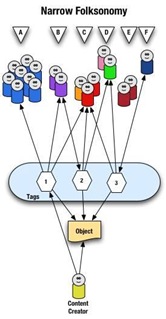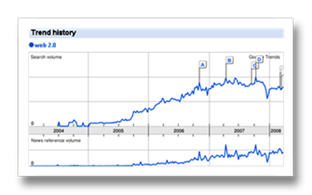‘Web 2.0’ and related concepts have been the most heard, most searched and most talked about terms on the web & otherwise. Since the time I first heard about ‘Web 2.0’, I have seen and read so many complex definitions that some-times I really wonder how difficult it must be to average ‘Joe’ to understand all the Geeky stuff.
(Search frequency for Web 2.0 across a span of last 5 years)
Several people come and ask me about these ‘terms’ giving me pointers that there is time to blog about it. Here’s a quick re-cap of some of the ‘Web2.0 concepts’ and the understanding that I’ve had so far:
RSS – ‘Really Simple Syndication’ Consider a ‘pipeline’ which streams water from the river to your homes. You need water for various purposes. Now replace water by ‘web content’ and homes by your ‘computer’. What we as users want is web-content to come to us on our computers. Oh yeah ! We want it for various purposes and various formats. So ‘RSS’ essentially acts as pipeline and it pushes web-content to us in the RSS feed readers.
Folksonomy – Tom is a ‘photographer’ and he wants to share his ‘Goa trip’ photographs via the web. Amongst the multiple options that Tom has he chooses to upload his photographs on Flickr.com. It is because Tom wants the photo-lovers community to take a look at his collection.
 So Tom puts a tag – ‘Goa pics’ to his photographs to make it easier for other users to locate..the pics. Remember Jack is the content (which in this case is the image)owner. Jack is searching for some ‘Goa pics’ and as a matter of fact locates Tom’s collection while browsing through the ‘Flickr’ stream. Jack and some other picture lovers add their own common tags to Tom’s collection.
So Tom puts a tag – ‘Goa pics’ to his photographs to make it easier for other users to locate..the pics. Remember Jack is the content (which in this case is the image)owner. Jack is searching for some ‘Goa pics’ and as a matter of fact locates Tom’s collection while browsing through the ‘Flickr’ stream. Jack and some other picture lovers add their own common tags to Tom’s collection.
So what we see here is a bunch of user-groups adding their own ‘tags’ based on their understanding to the same set of pictures. As Thomas Vander Wal says, the folksonomy is a means for people to tag objects (web pages, photos, videos, podcasts, etc., essentially anything that is internet addressable) using their own vocabulary so that it is easy for them to refine that information again.
The image on the left (original source Thomas Vander Wal’s blog) is an example of Narrow Folksonomy. It shows the content creator who has created the 1st tag. Then there are other groups of people (Group A & Group B) who have used the same tag. Group B also creates the second tag. For more on Folksonomy and its two forms: Narrow and Broad check out ‘Thomas Vander Wal’s’ great post 🙂
This completes the first part of Revisiting the Web2.0 dictionary then.
Other Posts on Web 2.0 : And you thought you didn’t know Web two dot ooh !!
Update – Also read David Meerman Scott’s blog-post defining Web2.0/Social-Media and definitions glossary on Mike’s Blog.











The folksonomy isn’t the means my friend. The folksonomy is the structure. The means is the software environment (flikr, facebook etc) the tags are being made in. Thomas Vander Wal doesn’t understand the English language very well.
Cool Blog!
Added http://www.dictionaryofwebcontent.com
Well explained. Thought provoking article